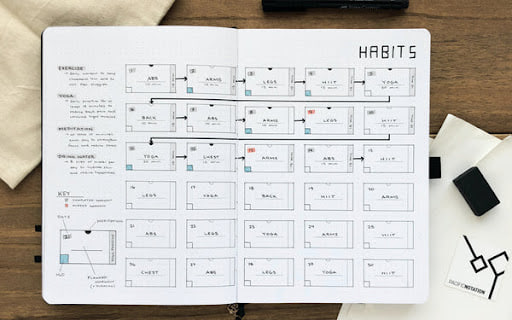Exploring Productivity Journal: Their Benefits, Types, and Effective Usage
There’s nothing more satisfying than a productive day. A day where you get everything done and can relax in the evening with a clear conscience. For most people, this feeling is rare. They lack the knowledge and tools to stay productive consistently. One way to gain that knowledge and tools is through a productivity journal.
In this article, we explore what a productivity journal is, the different types of journals, and how you can use them to increase your productivity.
What is a productivity journal?
As the name suggests, a productivity journal is a type of journaling that you can use to increase your productivity. It helps you plan for the future, learn more about yourself, and establish a system of accountability. It can also help you discover what changes you need to make to your workflow or lifestyle to increase your productivity.
What are the benefits of journaling daily in a productivity journal?
The obvious benefits are increased productivity and more efficient use of your time. But that’s not the only benefit. Here’s a list of some of the potential benefits you’ll gain from a productivity journal:
- Reduce procrastination: As you increase your ability to get things done in one area of your life, you’ll notice that things generally become easier. This can reduce procrastination.
- Reduce stress: Leaving things unfinished is a significant source of stress. When you’re more productive, you’ll likely have fewer unfinished tasks and a shorter to-do list, which can lead to lower stress levels.
- Improve mood and self-confidence: A productivity journal gives you a better approach to working on your goals and a straightforward way to track progress. This will boost your self-confidence and can improve your overall mood.
- Increase your chances of achieving your goals: Being more productive doesn’t guarantee that you’ll reach your goals, but it will increase your chances of doing so. The more you work toward your goals in an organized way, the more likely you are to achieve them.
- Opportunity to collect small wins: You earn small wins every time you overcome something difficult or do something good for yourself, which has many benefits. A productivity journal helps you gradually achieve these wins and celebrate the
Types of Productivity Journals
Different daily techniques can help you increase your productivity. They’re all worth trying, but some work better depending on your personality and goals.
Here are four different types and how to use them.
1. Today and Tomorrow (Reflection and Planning)
Today and Tomorrow journals help you increase your productivity by establishing a system of accountability. You can do this by reflecting on your productivity at the end of the day and preparing for tomorrow. Here’s how they work:
- Start journaling at the end of your day in a notebook, phone, laptop or anywhere else you can write.
- Start by writing down the date of the day. Then, under it, write down the times you worked and write a short note about your day. You can include anything that might have affected your productivity, such as mood, external factors, bad decisions, etc. Use constructive criticism and be honest with yourself.
- Create a section titled “What did I accomplish?” Here, review the tasks you actually planned to accomplish.
- Create a section titled “Today I Started.” Here, focus on all the work you have been able to start, as well as the tasks you have planned.
- Create a section titled “Tomorrow I will do X.” In this section, plan and decide what tasks you will complete tomorrow.
- If you notice that there is something that can be improved, you can write a short note about it and how to improve it here.
- Repeat the process at the end of each day.
_ILLAFTrain_2b1adf6790c20690016845130bcc75ac6ea624b0_a1d5d8830e2c5140b15dbb28ca4ab216.jpg)
2. Self-assessment and improvement
The self-assessment and improvement journal focuses on the overall goal. Its goal is not to complete specific tasks or achieve intermediate goals but to increase your future opportunities.
In this journal, you reflect on when and how you are truly productive, your lifestyle, and other relevant factors. Ask yourself these questions for this type of journaling:
- How do you define productivity?
- What conditions increase your productivity?
- What decreases your productivity?
- At what time of day are you most productive?
- At what time of day are you least productive?
- Are you eating healthy? Should you reduce or increase anything?
- Are you getting enough restful sleep?
- Are you tired? If so, why?
Answering these questions can give you a deeper insight into the factors that affect your productivity, helping you improve it and boost your future prospects.
Once you’ve answered these questions, you can start summarizing your points. What should you do, what could you do better, and what should you avoid? Use these questions to create the perfect conditions for being productive.
Unlike a Today and Tomorrow diary, you don’t have to write this daily. Once a week, or even once a month, is enough to see progress if you take it seriously and apply what you’ve learned.
3. Thought Tracker
It is a unique writing technique where you track your thoughts and write down exactly what is on your mind. It has no specific structure, and you don’t need to think about anything other than writing down your thoughts as they are. These notebooks are usually used for self-exploration and stress relief, but they can also be an effective tool for increasing productivity.
All you have to do is start thinking about your productivity. Think about what productivity means to you, how you can achieve it, and what factors help or hinder you. Focus on these thoughts and write them down as they are without any restrictions. Follow your train of thought, and don’t worry about being right or wrong. Everything that comes to your mind is important and should be written down.
4. Goal Notebook
A goal notebook is a type of notebook that helps you define your goals and what you need to do to achieve them. When you define your goals and write them down correctly, you will understand what you want and need to do to achieve them.
How to Use a Productivity Notebook?
At this stage, you understand the purpose of a productivity notebook and know the different techniques. Here are six tips to help you get started and get the most out of your productivity journal.
1. Choose the Right Type(s)
You'll benefit from different types of productivity journals depending on who you are and what your work is. Below, we’ll briefly explore when different techniques work best.
Today and Tomorrow Journal
This is useful when you know what to do and how to do it best but struggle to get things done.
Self-Assessment and Improvement Journal
This type of journal works best when you don’t know what you need to do to be more productive. It can be used when you have something specific to work on and when you don’t have anything specific.
Thread of Thought Journal
This is similar to the Self-Assessment and Improvement Journal and works best under the same circumstances.
Goal Journal
A goal journal is useful when you’re unsure what you want or how to achieve it.
Sometimes, you’ll find that you only need one of these journals, but often, you’ll need a combination of them. Experiment with different techniques and see which one works best for you.
2. Get in the habit of journaling
Journaling when you’re feeling motivated may be easy, but you won’t always feel motivated. Getting into the habit of journaling in a productivity journal can make it easier to stick to it on tough days.
There are several ways you can do this. Try setting a specific time each day to write, making journaling part of your routine, or using one of the other techniques listed here.

3. Strive for moderation, not perfection
Your productivity journal doesn’t have to be perfect, just acceptable. Don’t worry about spelling or grammar mistakes, how your writing sounds, or your wording. Striving for perfection can feel satisfying, but it can distract you from your main goal, which is to be more productive. It can also make it harder to stay consistent.
Recognize that you’re the only one who needs to see your journal, so don’t worry about spelling mistakes or poor formatting.
4. Analyze yourself and your performance
There will inevitably be times when you struggle with productivity. These periods can be frustrating, but if you analyze yourself and your performance on a regular basis, they can help you understand yourself better and prepare for the next time you face these difficulties.
5. Use a notebook as a to-do list or link it to it
Most of us have a to-do list, but sometimes we find it challenging to complete it. This can be frustrating and affect our overall productivity. By linking a productivity notebook to a to-do list, such as today’s and tomorrow’s notebook, it will be easier to complete them. This can improve our overall productivity.
6. Be patient
Increasing productivity is a gradual process. The more you practice journaling gradually, the better you will get, but it doesn’t necessarily happen quickly.
Your average daily productivity may not increase much day by day. But when it accumulates over weeks and months, it will be significant. Be patient and persevere. Soon, the results will be visible.
In conclusion
A productivity notebook is one of the few tools that can give you more time in your day. Not because you get more hours but because you are investing your time better by using it.
You may not achieve the results you want from day one, but with patience and perseverance, you will.


 Main menu
Main menu





